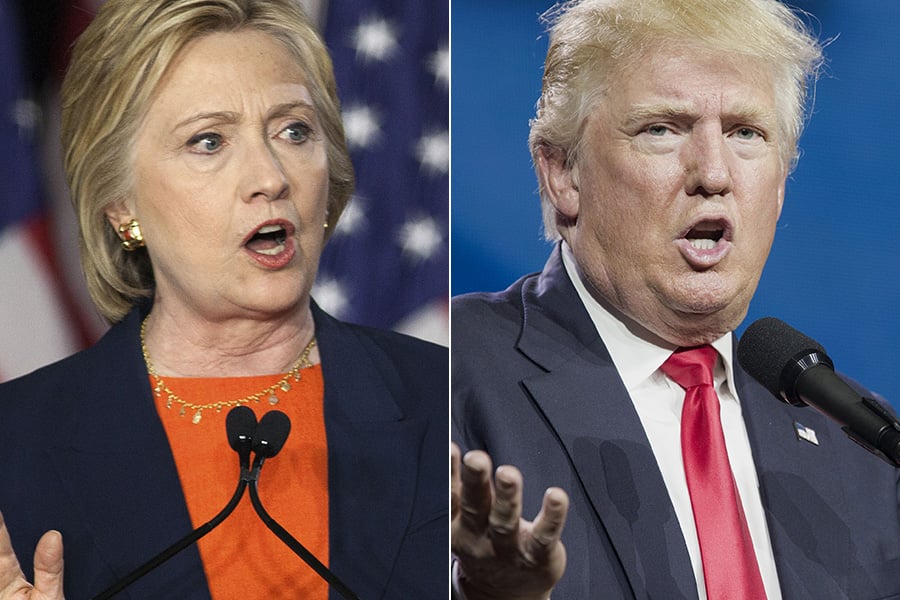In a comparison of the economic policies proposed so far by presidential candidates Hillary Clinton and Donald Trump, Moody's Analytics has given the nod to the former Secretary of State.
“Evident from her proposals is the belief that the country needs to invest more in education, infrastructure and workers, and that the well-to-do, and to a lesser degree financial institutions and businesses should pay for it,” the Moody's report summarized.
“While [Ms. Clinton's] budget arithmetic does not completely add up, it is pretty close, and the nation's debt load under her plan is not different than under current law,” the report added.
The Moody's report, co-authored by chief economist Mark Zandi, director Chris Lafakis, and economist Adam Ozelmek, followed an earlier analysis of Mr. Trump's economic policy proposals.
While Ms. Clinton is proposing tax hikes along with more than $2 trillion in new spending over 10 years, the
Moody's analysis said her plans would slightly improve the direction of the economy, compared to current economic policy.
Critics could read this to suggest Ms. Clinton is extending the policies set by President Barrack Obama.
The report gives the Democratic nominee credit for expanding the supply side of the economy, including the quantity and quality of labor and capital needed to produce goods, but also points out the long-term costs of higher taxes as a disincentive to save, invest and work.
“Her proposals also do little to directly promote increased private sector investment,” the report stated. “The campaign has suggested that a proposal to reform the corporate tax code that would presumably promote business investment is forthcoming, but this is not included in this analysis as it has not been formally proposed.”
By contrast, the analysis of Mr. Trump's economic proposals shows increased spending on veterans and the military combined with corporate and personal tax cuts.
The
report calculates that the Republican nominee's policies will weaken the economy and result in 3.5 million fewer jobs and an unemployment rate of 7% by 2026, compared to 5% today.
“Everyone receives a tax cut under his proposals, but the bulk of the cuts would go to those at the very top of the income distribution, and the job losses resulting from his other policies would likely hit lower- and middle-income households the hardest,” the report states.
The forecast that applies Mr. Trump's economic proposals, compared to current law, would result in a less global U.S. economy, larger government deficits and more debt, and a weaker U.S. economy.
“Both of them are planning on spending a significant amount of money, but on different things,” said Carolyn McClanahan, director of financial planning at Life Planning Partners.
Ms. McClanahan added that she believes Ms. Clinton has a tax plan, while Mr. Trump does not.
However, she admits, neither candidate has fully explained how all the spending will be paid for either through higher taxes, more government debt, or a combination of both.
“People always think the president has much more impact on the economy than they actually have,” Ms. McClanahan said. “The biggest difference I'm expecting is an increase in taxes to pay for all their proposals.”
Whether presidents deserve credit or not for the economy, the Moody's report applied the two candidates' economic proposals to multiple economic and financial market measurements over the next 10 years.
Under Ms. Clinton's proposals, the S&P 500 Index would produce an average annual growth rate of 1.7% through 2020, and 5.7% through 2026.
Under Mr. Trump, the S&P's average annual growth rates would see a 1.2% decline through 2020, and a 4% gain through 2026.
The economy under Ms. Clinton's proposals would grow at an average annualized rate of 2.7% through 2020, and 2.4% through 2026.
Under Mr. Trump's proposals, the economy would grow at a 0.6% rate through 2020, and 1.4% through 2026.
The unemployment rate under Ms. Clinton would be at 4.4% in 2020, and 5.3% in 2026. While the yield on the 10-year Treasury bond would be at 4.6% in 2020, and 3.5% in 2026, which compares to 1.54% today.
Under Mr. Trump, the unemployment rate is projected to be at 6.8% in 2020, and 4.8% in 2026.
The yield on the 10-year Treasury would be at 7% in 2020, and 6.7% in 2026.
To be clear, the Moody's analysis was based entirely on spoken and documented statements attributed to each candidate. And, as the analysts pointed out, “No one expects that their proposals will get through the legislative process and into law fully intact.”
Looked at another way, last month, and analysis by S&P Global Market Intelligence evaluated how
each of the 10 sectors of the S&P 500 would be impacted by policies being proposed by the two candidates.
Ed Butowsky, managing partner at Chapwood Capital Investment Management, understands that presidents typically get too much credit and too much blame for overall economic and market conditions, but he thinks the next president will need to embrace a less-discussed reality.
“To think about any economic plans you have to first think about the condition of the country right now, which is modern-day stagflation,” he said. “Despite the data, the reality is we've got high unemployment because we're not counting all the people who have stopped looking for work, we've got slow economic growth, and prices are rising.”
Historically, stagflation is attacked by either dramatically increasing money in the system through stimulus programs, or by cutting taxes.
With that in mind, Mr. Butowsky believes Mr. Trump's plan is superior.
“Most of the time the president does not have a major impact on the economy, but this is one of those times when it's so obvious what needs to happen,” he said. “The only solution to fix the economy is Trump's approach, because Hillary's approach would only make things worse.”







